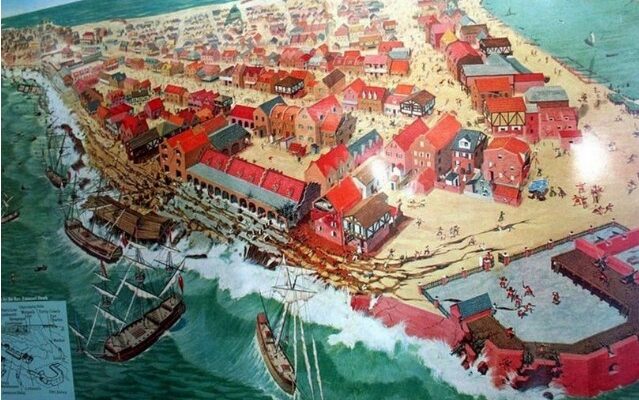Port Royal in Jamaica was notoriously dubbed “the wickedest city on Earth” in the 17th-century, owing to its bloodthirsty population of rascals and pirates
Once home to the real Pirates of the Caribbean, Port Royal in Jamaica was regarded as the “wickedest city on earth”.
At its peak in the 17th century, the city was bustling with pirates and traders seeking prostitutes and rum.
It was a haven for immoral behaviour with one in every four buildings said to be a bar or a brothel.
Just six miles out to sea from Kingston Harbour, it attracted notorious figures such as Henry Morgan.
It was also the most important trading post for slaves in the New World, especially for Brits following the invasion of Jamaica in 1655.
But much of the city’s famous excess and debauchery was washed away in 1692, following an earthquake and tsunami.
Disaster struck again in 1703 when a fire broke out in a warehouse, reducing the entire town to ashes.
Now the majority of the city can only be seen underwater after it became submerged in a matter of minutes.
Today, Port Royal is a small fishing village hoping to use its incredible history as a home to the real pirates of the Caribbean to attract visitors.
At its peak, the city was the stuff of legends, and became known as “the Sodom of the New World”.
Port Royal was one of the busiest ports for British and French privateers – especially because of the maritime slave trade.
Between the sixteenth and nineteenth centuries, there were different types of pirates, including privateers, buccaneers and corsairs.
In Port Royal, privateering was approved by the British Crown in return for some of the assets being handed over to the town government.
And in 1657, governor Edward D’Oley invited a group of privateers dubbed the Brethren of the Coast to make Port Royal their home port, in a bid to boost trade.
That included Welshman Henry Morgan, who went on to have Captain Morgan’s rum named after him.
Following his appointment as lieutenant governor in 1674, the selling of slaves in Port Royal took on greater importance.
Smuggling boomed in Jamaica, as Spanish ports in the New World were closed to foreigners but there was a huge demand for African slaves and goods made in Europe.
This led to Port Royal growing at a faster rate than any other town founded by the English in the new world.
Its citizens were unafraid to splash the cash, with records showing they would spend one or two times the annual wage of a plantation worker in one night.
Fuelled by the famous blackout-inducing “Kill Devil rum”, sordid deals involving gold, rubies and other high value items took place between traders at taverns.
Other establishments invited patrons to bet on rooster-fighting or bull and bear fighting.
Historian Charles Leslie wrote about the city’s residents in his history of Jamaica. He wrote: “Wine and women drained their wealth to such a degree that some of them became reduced to beggary.
“They have been known to spend 2 or 3,000 pieces of eight in one night and one gave a strumpet 500 to see her naked.”
But the hustle and bustle of Port Royal suddenly ended after two thirds of the city sunk under the harbour in a matter of minutes in 1692.
An earthquake and tsunami killed an estimated 2,000 people – but left much of the city perfectly preserved underwater.
A further 3,000 citizens tragically died of injuries and disease shortly after.
Survivor Dr Edmund Heath, rector of Port Royal, recalled watching around 33 acres of the city disappear.
He wrote: “I saw the earth open and swallow a multitude of people; and the sea mounting in upon us over the fortification.”
And Atlas Obscura reports how citizens were so badly behaved that they began to loot, even whilst the city was still sinking.
One local wrote : “Immediately upon the cessation of the extremity of the earthquake, your heart would abhor to hear of the depredations, robberies and violences that were in an instant committed upon the place by the vilest and basest of the people; no man could call any thing his own, for they that were the strongest and most wicked seized what they pleased….”.
Now archaeologists who have visited the settlement underwater have captured photos of an incredible submerged city under the waves – with the old port’s sea boundaries still standing.
Many buildings were left intact following the disaster, leading to comparisons with Pompeii.
Divers visiting the site have turned up artifacts including wine glasses, ceramic plates and even the partial skeleton of a child in 1998.
The city was also the setting for the film Pirates of the Caribbean, although it was actually filmed in Saint Vincent and the Grenadines.



